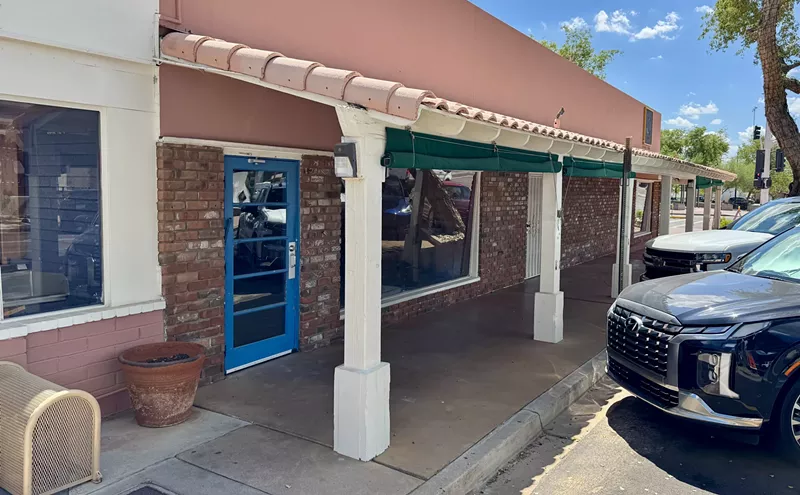This untitled 16mm film, recently discovered under a pile of paintings in the Arizona Historical Foundation archives, depicts the early days of Poston, one of the two Japanese internment camps set up in Arizona during World War II. The film opens with an aerial view of the Arizona desert skyline circa 1942, a vast and peaceful vista that's quickly disrupted with shots of bulldozers upending the land and huge fires ravishing a mesquite bosque, much to the off-camera horror of the Colorado Indian tribes who lived there. The impossibly vibrant colors made by blazing orange flames against a blue sky are captivating, even beautiful — until one realizes they're scenes from a kind of horror film.
In March 1942, President Franklin D. Roosevelt signed an order detailing the immediate building of 10 "relocation camps" designed to house more than 110,000 Japanese Americans then living along the Pacific Coast. Two of the largest camps were located in Arizona: the Gila River Relocation Center, located on leased Pima-Maricopa Indian lands in central Pinal County, and the Colorado River Relocation Center, known simply as Poston, on Colorado Indian land near Poston, Arizona, 12 miles southwest of Parker in La Paz County.
Despite the fact that throughout the course of the war, fewer than a dozen people — all of them Caucasian — were convicted of spying for Japan, and even though two-thirds of those interned were United States citizens, these victims of wartime hysteria were forced to leave their homes and live in tarpaper barracks, under armed guard and behind barbed-wire fences, for nearly four years. During their peak populations — Poston housed about 18,000 detainees, while Gila River had close to 13,000 — these Japanese internment camps were the third and fourth largest "cities" in the state, after Phoenix and Tucson. Citizens of Southern California, Kern County, Fresno, Monterey Bay, Sacramento County, and southern Arizona were dumped into Poston like cattle, yanked from their lives because of what we would today call racial profiling.
It's a tragedy that few Arizonans know about, one that's been swept under the carpet by historians who prefer to ignore our state's more tawdry past. But covering up this shameful chapter in state history has become more difficult since Linda Whitaker found the 25-minute, silent color movie last fall. Whitaker, an archivist at the Arizona Historical Foundation, discovered the film canister while preparing an exhibition on World War II Japanese internment camps. It's not known who made the movie or what its purpose was; in their attempts to clarify the film's pedigree, Whitaker and her colleagues have consulted with film specialists, internment camp historians, and World War II aficionados, all of whom insist that this film can't possibly exist.
"But guess what, folks?" Whitaker says. "It does exist, and we have it. It hadn't been out of its can since 1942, but it's a remarkable 25 minutes that changes our ability to pretend this awful thing never happened. Archivists aren't an excitable bunch, but this film brought us to our knees."
It's easy to see why. The first half of the film is devoted to scenes of frantic construction as building contractor Del Webb's 5,000-member crew saws wood, pounds nails, and pours foundations for what clearly becomes, halfway through the movie, a barracks full of redwood A-frames with tarpaper walls. In an almost balletic and obviously choreographed sequence, an African-American site boss instructs his crew to raise the wall of one of the buildings, then literally dances through the doorway of that wall to the next one. After this second wall is raised, the site boss raises his arms into the air in a stagy, fey flourish of victory. It's a creepy moment made even more chilling by the efficiency with which the camp is erected — an efficiency powered by an angry, paranoid government.
We're left to guess at the film's original purpose, although there are some clues both in its production qualities and the tenor of some of the later scenes involving detainees. The film has been edited with professional-quality fades between scenes, and it's shot in color. Most color film stock was confiscated by the government in 1942 for use in documenting the war, making it likely that this was a government-sponsored film.
"We think it's a propaganda film," Whitaker says, a claim that seems likely given what's not depicted here, like the tens of thousands of Japanese-Americans who were forced to liquidate family businesses and leave their homes; or the tribal councils at which Native Americans were told that the government was going to build an internment prison on their land whether they liked it or not. We're shown instead some insert shots of shuttered Japanese storefronts with "Going Out of Business" and "Must Liquidate" signs in their windows, and there isn't a Native American in sight. It's a shiny, happy version of the birth of a concentration camp and the lives eventually lived there.
The film's soundtrack might have offered some clues, but, while the magnetic strip that probably held it is intact, the sound itself has long since disappeared, deterioration common in old magnetic film.
If a soundtrack had been recorded, it was likely a voice-over narrative, according to WWII historian Steve Hoza, an archivist at Hoo-hoogam Ki Museum and author of PW: First-Person Accounts of German Prisoners of War in Arizona. "Synchronized sound in a news short was rare at the time," Hoza says. "Frankly, a newsreel about an internment camp wouldn't have had high production values because — and I hate to say this — most Americans didn't care."
In an era when the Arizona Republic was publishing "Little Itchy Itchy," a loathsome Japanese stereotype drawn by Pulitzer Prize-winning political cartoonist Reg Manning, the attitude among many Americans seemed to be "a Jap is a Jap." A headline in the San Francisco Examiner of the time read, "Ouster of All Japs in California Near!"
"Racism was more blatant back then," Hoza says, "especially as regards the Japanese during wartime. A lot of people who saw this film would have thought these people deserved internment because of Pearl Harbor. They looked like the enemy."
And they were treated like the enemy, once Poston and its sister site were completed. "The last five minutes of this movie," Whitaker says, her voice filled with dismay. "Oh, man, it's hard to watch."
Indeed, the final scenes showing Japanese-American detainees arriving at Poston are among the film's most disturbing. They're seen stepping off dusty buses and crowded trains, dressed in their Sunday best — the women in hats and gloves; the little girls in party dresses and Mary Janes — wearing confused, defeated expressions. They're shown blinking into the harsh light, drinking from paper cones of water as clouds of dry dust blow past. It's not hard to imagine how the hot, oppressive July day felt — the average temperature in Parker that month in 1942 was 109 degrees — or what it felt like to arrive in a camp surrounded by barbed wire and a guard tower. Oral accounts from Poston survivors claim they didn't know where they were going. "They must have thought they had landed in hell," Whitaker says.
The last scenes in this odd newsreel attempt to depict a pleasant life in the hot, dusty desert camp. In one sequence, a boy gets a haircut while his mother looks on, smiling and chatting with the barber. In another, a group of boys plays baseball in a dirt field. In yet another, a woman cheerfully hangs wet canvas in the window of her tarpaper home, the only form of air conditioning in this sweltering prison. These scenes are clearly orchestrated to make life in Poston look like a brief wartime respite, but in every frame, there's desperation, heat, oppression.
"They were locked up in this place for almost four years," Whitaker says. "We'd like to think this could never happen today, but then you watch how efficiently our government locked up thousands of people because of their ethnicity, and you realize this film was shot only 60 years ago, and you start to think, 'Have things changed? Have they?'"







